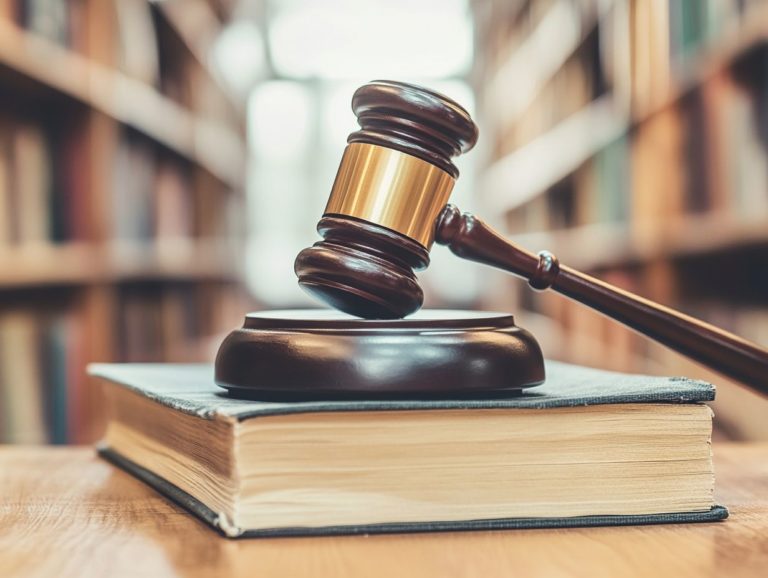Understanding the Trade Secret Litigation Process
In today s fiercely competitive business landscape, safeguarding your sensitive information is paramount. Trade secrets are essential for maintaining that competitive edge.
When disputes over these secrets arise, litigation may become unavoidable. Dive into the exciting world of trade secret litigation and discover how to protect your vital information! This article helps you define what a trade secret truly is and clarifies the legal protections available.
It will walk you through the steps of the litigation process, highlight the key factors for success, and even explore alternatives like mediation. Whether you’re on the brink of a potential lawsuit or simply seeking to understand your rights, this comprehensive guide will provide you with invaluable insights.
Contents
- Key Takeaways:
- What is Trade Secret Litigation?
- Steps in the Trade Secret Litigation Process
- Key Factors in a Successful Trade Secret Litigation Case
- Alternatives to Litigation
- Frequently Asked Questions
- What is the purpose of understanding the trade secret litigation process?
- What is a trade secret?
- What is trade secret litigation?
- What are the steps involved in the trade secret litigation process?
- What is the statute of limitations for trade secret litigation?
- Do I need a lawyer for trade secret litigation?
Key Takeaways:

- Trade secret litigation involves legal action to protect confidential information from unauthorized use or disclosure.
- Important steps in the process include pre-litigation considerations, filing a complaint, gathering evidence, and potential trial outcomes.
- Successful cases depend on proving unauthorized use and the resulting damages, but alternative options like mediation may also be considered.
What is Trade Secret Litigation?
Trade secret litigation encompasses the legal measures taken to safeguard confidential and proprietary information from unauthorized use and corporate espionage.
This type of litigation aims to uphold trade secret protections under various laws, including the Economic Espionage Act and the Defend Trade Secrets Act, both of which offer legal remedies for plaintiffs confronting the infringement of their trade secrets.
Companies frequently engage in trade secret litigation to protect their competitive edge. The unauthorized use of sensitive information can lead to substantial financial losses and disrupt their market position.
Defining Trade Secrets and Legal Protections
Trade secrets encompass the confidential information and proprietary knowledge that give your business a competitive edge think formulas, practices, and processes. Understanding what qualifies as a trade secret is vital; it s not just about the information itself but also the measures taken to safeguard it.
For information to earn the title of a trade secret, it must maintain its secrecy through reasonable efforts. This can involve using non-disclosure agreements and implementing limited access protocols to keep your valuable insights under wraps.
You also have legal protections against unauthorized use, with remedies provided under the Uniform Trade Secrets Act and the Defend Trade Secrets Act. It is essential to be vigilant in safeguarding your proprietary assets.
The consequences of trade secret theft can be dire, leading to financial loss, a weakened market position, and erosion of brand trust. Protecting your trade secrets is crucial for your business’s survival and growth.
Steps in the Trade Secret Litigation Process
The trade secret litigation process includes several critical steps that you must navigate to secure legal remedies and protect your proprietary information from unauthorized use.
Each stage plays a vital role in ensuring your interests are protected as you seek justice in this complex legal landscape.
Pre-Litigation Considerations

Before diving into trade secret litigation, meticulously evaluate your reasonable efforts in managing trade secrets and consider implementing protective measures against potential employee misconduct. This assessment is essential; it allows you to pinpoint any gaps in your current strategies and practices.
By reviewing past actions, you can discern whether adequate safeguards were established, such as:
- Conducting employee training sessions on confidentiality
- Restricting access to sensitive information
- Utilizing non-disclosure agreements
Acknowledging the measures you’ve taken to protect your intellectual property will strengthen your case if litigation becomes necessary. Strong documentation and a clear record of precautionary steps can significantly enhance your position in court, showcasing that you had reasonable and proactive strategies in place to safeguard your critical assets.
To ensure your trade secrets remain protected, consider consulting with a legal expert to assess your situation and develop a robust strategy.
Filing a Complaint
Filing a complaint is an important step in trade secret litigation. Here, you, as the plaintiff, present your claims to a civil court, detailing the theft of your confidential business information and the damages that ensue.
This initial document serves as the foundation of your case, requiring you to articulate the specific facts surrounding the alleged theft.
Essential components include a clear description of the trade secrets involved, a comprehensive outline of how these secrets were unlawfully acquired or used, and a detailed report quantifying the financial impact on your business.
By ensuring your claims are backed by solid evidence, you not only fortify your case but also help the court grasp the gravity of the situation. Present your complaint without delay to protect what s rightfully yours!
Discovery and Evidence Collection
The discovery phase in trade secret litigation is crucial for evidence collection. It enables you to inspect documents and conduct judicial inspections that support your claims.
During this pivotal stage, examining communications, contracts, and data logs can reveal vital information that underscores the theft of your sensitive information.
It’s also essential for you, as the aggrieved party, to meticulously gather and present this evidence. This effectively showcases not only the illicit acquisition of your proprietary knowledge but also the accountability of the defendants involved.
By ensuring a thorough collection of facts, you can construct a formidable case that highlights the defendants’ liability and reinforces the integrity of intellectual property rights within the industry.
Trial and Potential Outcomes
The trial phase in trade secret litigation is your moment to shine. Here, you can present your case and pursue various outcomes, such as damages or a court order that stops the infringing party from doing something.
During this pivotal stage, the court meticulously evaluates evidence, listens to testimonies, and assesses the validity of your claims concerning the misappropriated trade secrets.
Potential outcomes may range from compensatory damages for lost profits to punitive damages designed to deter similar misconduct in the future.
These decisions can dramatically reshape the competitive landscape, underscoring the importance of thorough legal preparation and a compelling presentation of facts on your part as the plaintiff.
Key Factors in a Successful Trade Secret Litigation Case

Several key factors play a crucial role in the success of trade secret litigation. Your capacity to prove theft and to convincingly demonstrate that you took reasonable measures to safeguard the trade secrets involved is essential.
Proving Misappropriation and Damages
To succeed in trade secret litigation, you must prove misappropriation with compelling evidence that establishes the defendant’s liability. This means demonstrating that the defendant acquired your secret through improper means, like breaching confidentiality or engaging in espionage.
You can use direct evidence, like testimony from key witnesses, and circumstantial evidence, which might include emails or documentation that hint at an intent to misuse trade secrets.
Once you establish misappropriation, calculating damages becomes critical. Courts will examine the actual losses you’ve suffered, any lost profits due to the misuse, and, in some cases, any unjust enrichment, which means the defendant unfairly gained money or benefits at your expense.
It s vital to clearly outline these damages to present a compelling case that resonates with the court.
Alternatives to Litigation
While litigation often serves as a go-to option for enforcing trade secret protection, you should also explore various alternatives that businesses can consider.
Mediation and settlement options, for instance, can provide effective pathways to resolving disputes without the need for lengthy court battles.
Mediation and Settlement Options
Mediation offers a collaborative way to resolve trade secret disputes. It allows you to explore settlement options without the complexities of litigation.
A neutral third party, the mediator, facilitates communication between the involved parties. The mediator helps you find common interests, guiding you toward a solution that works for everyone.
This friendly space invites open conversation, reduces hostility, and boosts cooperation.
Successful mediation leads to great outcomes. These might include confidentiality agreements or improved business practices, enhancing your trade secret protection.
Frequently Asked Questions

What is the purpose of understanding the trade secret litigation process?
Understanding the trade secret protection process helps you know how to protect your confidential information. This knowledge can prevent theft or misuse by competitors.
What is a trade secret?
A trade secret is confidential information that gives a business a competitive edge. Examples include customer lists, manufacturing methods, and financial data.
What is trade secret litigation?
Trade secret litigation is a legal process for resolving conflicts over the theft or misuse of confidential information. It may involve taking action against those who improperly used or disclosed a trade secret.
What are the steps involved in the trade secret litigation process?
The trade secret litigation process usually follows these steps: 1) Identifying the trade secret(s), 2) Gathering evidence, 3) Filing a court complaint, 4) Participating in pre-trial procedures, 5) Attending the trial, and 6) Possibly appealing the decision. For more detailed insights, you can check what to expect during an IP litigation process.
What is the statute of limitations for trade secret litigation?
The time limit to file a trade secret case varies by state, typically ranging from 3 to 6 years from when the secret was misappropriated. It s wise to consult a lawyer for your specific timeline.
Do I need a lawyer for trade secret litigation?
While hiring a lawyer isn’t legally required, it’s highly recommended. Trade secret cases can be tricky, and a lawyer can boost your chances of success.






